You can't have multiple drivers for any given signal
From your description, it sounds like you are trying to work out some sort of handshaking between your two processes. While there may be a more elegant solution, without having seen your code, let's assume you actually do need handshaking. Even if you don't need it now, you may later.
To assist the discussion, I'll model the behavior using two components (or entities) instead of processes, so the diagram is more clear.
Assume you have one entity which receives data and another which processes the data. Also assume you only want to receive new data while the processor is idle (ie. it has finished working on the last data set).
For this, you'll need some handshaking. The first entity (call it data_memory) needs to know when the data_processor is idle, and the data_processor needs to know when the memory has data_rdy.
This resembles your post:
I would like to have some indicator (just for example only one) informing that there is a new data. One process set the flag if new data is available, other one clear flag after read. [sic]
Here we have a flag data_rdy which is set when new data is available, and cleared after it is read and processed:

For the data_memory instance, we can just clock the data directly from data_in to the data_processor whenever the write enable wren is high. The data_rdy flag lets the processor know when new data is ready and waiting.
-- data_memory.vhd
library ieee;
use ieee.std_logic_1164.all;
entity data_memory is
port ( data_in : in std_logic_vector (7 downto 0);
wren : in std_logic;
rdy_read : in std_logic;
clk : in std_logic;
data_out : out std_logic_vector (7 downto 0);
data_rdy : out std_logic );
end data_memory;
architecture Behavioral of data_memory is
begin
process (clk)
begin
if (rising_edge(clk)) then
if (wren = '1') then
-- in practice, we would add a queue here
data_out <= data_in;
end if;
data_rdy <= wren and rdy_read;
end if;
end process;
end Behavioral;
The data_processor then uses the data whenever the data_rdy signal is high:
-- data_processor.vhd
library ieee;
use ieee.std_logic_1164.all;
entity data_processor is
port ( data_in : in std_logic_vector (7 downto 0);
data_rdy : in std_logic;
clk : in std_logic;
data_out : out std_logic_vector (7 downto 0);
idle : out std_logic );
end data_processor;
architecture Behavioral of data_processor is
signal process_wait_cycle : std_logic_vector (63 downto 0) := (others => '1');
begin
process (clk)
begin
if (rising_edge(clk)) then
if (data_rdy = '1') then
-- in practice, we would actually do something with the data;
-- here we'll just make a copy and send it out
data_out <= data_in;
process_wait_cycle <= (others => '0');
idle <= '0';
else
process_wait_cycle <= process_wait_cycle(62 downto 0) & '1';
idle <= process_wait_cycle(63);
end if;
end if;
end process;
end Behavioral;
The process_wait_cycle shift register is used here only as a means to eat up some clock cycles to simulate a processing time. When the processing is complete, the entity sets the idle flag high, which then loops back to the input of the data_memory block.
Finally, we can tie these two together in a top-level instance:
-- transmission.vhd
library ieee;
use ieee.std_logic_1164.all;
entity transmission is
port ( data_in : in std_logic_vector (7 downto 0);
wren : in std_logic;
clk : in std_logic;
data_out : out std_logic_vector (7 downto 0);
data_status : out std_logic );
end transmission;
architecture Behavioral of transmission is
-- Component data_memory
component data_memory is
port (
data_in : in std_logic_vector (7 downto 0);
wren : in std_logic;
rdy_read : in std_logic;
clk : in std_logic;
data_out : out std_logic_vector (7 downto 0);
data_rdy : out std_logic );
end component;
-- Component data_processor
component data_processor is
port (
data_in : in std_logic_vector (7 downto 0);
data_rdy : in std_logic;
clk : in std_logic;
data_out : out std_logic_vector (7 downto 0);
idle : out std_logic );
end component;
-- Signals
signal data_rdy : std_logic := '0';
signal processor_ready : std_logic := '0';
signal data_from_mem : std_logic_vector (7 downto 0) := X"00";
begin
data_status <= data_rdy;
-- data_memory instance
data_memory_inst : data_memory
port map (
data_in => data_in,
wren => wren,
rdy_read => processor_ready,
clk => clk,
data_out => data_from_mem,
data_rdy => data_rdy );
-- data_processor instance
data_processor_inst : data_processor
port map (
data_in => data_from_mem,
data_rdy => data_rdy,
clk => clk,
data_out => data_out,
idle => processor_ready );
end Behavioral;
And simulate:

Here you can see that data is only used when wren and idle is high, indicating that both the processor is idle, and new data is incoming.
In case you're interested in the simulation file:
-- Transmission sim
library ieee;
use ieee.std_logic_1164.all;
use ieee.math_real.all;
use ieee.numeric_std.all;
entity transmission_sim is
-- Port ( );
end transmission_sim;
architecture Behavioral of transmission_sim is
component transmission is
port ( data_in : in std_logic_vector (7 downto 0);
wren : in std_logic;
clk : in std_logic;
data_out : out std_logic_vector (7 downto 0);
data_status : out std_logic );
end component;
signal data_in : std_logic_vector (7 downto 0) := X"AB";
signal wren : std_logic := '0';
signal clk : std_logic := '0';
signal data_out : std_logic_vector (7 downto 0) := X"00";
signal data_status : std_logic := '0';
constant PERIOD : time := 10 ns;
constant DUTY : real := 0.5;
begin
uut : transmission
port map (
data_in => data_in,
wren => wren,
clk => clk,
data_out => data_out,
data_status => data_status );
process
begin
loop
clk <= '0';
wait for (PERIOD - (PERIOD * DUTY));
clk <= '1';
wait for (PERIOD - (PERIOD * DUTY));
end loop;
end process;
process
variable seed1, seed2: positive;
variable rand: real;
variable range_of_rand : real := 255.0;
begin
wait for (PERIOD*10);
wren <= '1';
wait for (PERIOD*10);
wren <= '0';
wait for (PERIOD*10);
uniform(seed1, seed2, rand);
data_in <= std_logic_vector(to_unsigned(integer(rand*range_of_rand), data_in'length));
end process;
end Behavioral;

